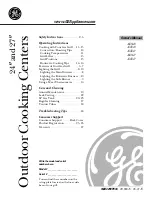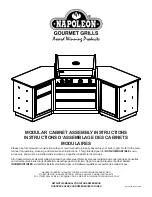
19
ENGLISH
ADDITONAL SAFETY WARNINGS
4) Be sure no one is below you when using the tool in high locations.
5) Hold the tool firmly with both hands.
6) Keep hands away from rotating parts.
7) Do not leave the tool running. Operate the tool only when hand-held.
8) Do not touch the bit or the work piece immediately after operation;
they may be extremely hot and could burn your skin.
9) Some material contains chemicals which may be toxic. Take caution
to prevent dust inhalation and skin contact. Follow material supplier
safety data.
2. Important safety instructions for charger
Do not let comfort or familiarity with your tool replace strict adherence to
cordless drill safety rules. If you use this power tool unsafely or
incorrectly, you can suffer serious personal injury.
1) Before using the charger, read all the instructions and cautionary markings
on the charger and battery pack as well as the instructions on using the
battery pack.
2) Only charge your batteries indoors as the charger is designed for indoor
use only.
3)
DANGER.
If the battery pack is cracked or damaged in any other way, do
not insert it in the charger. There is a danger of electric shock or
electrocution.
4)
WARNING.
Do not allow any liquid to come into contact with the charger.
There is a danger of electric shock.
5) To allow the battery pack to cool down after charging, do not place it in a
hot environment such as a metal shed or open trailer left in the sun.
6) The charger is not intended for any use other than charging the exact type
of rechargeable battery pack as supplied with the charger. Any other use
may result in the risk of fire, electric shock or electrocution.
7) The charger and battery pack supplied with it are specifically designed to
work together. Do not attempt to charge the battery pack with any other
charger than the one supplied.
8) Do not place any object on top of the charger as it could cause
overheating. Do not place the charger near any heat source.
9) Do not pull on the plug of the charger to disconnect it from the power
source.
10) Make sure that the charger cable is positioned where it will not be stepped
on, tripped over or otherwise subjected to damage or stress.
11) Do not use an extension cord with the charger unless it is absolutely
necessary. The use of an improper extension cord could cause the risk of
fire, electric shock or electrocution.
12) Do not use the charger if it has been subjected to a heavy knock, dropped
or otherwise damaged in any way. Take the charger to an authorized
service centre for a check or repair.
13) Do not disassemble the charger. Take it to an authorized service centre
when service or repair is required. Incorrect re-assembly may result in the
risk of fire, electric shock or electrocution.
14) To reduce the risk of an electric shock, unplug the charger from the power
supply before attempting to clean it. Removing the battery alone does not
reduce the risk.
15) Do not store or use the tool and battery pack in locations where the
temperature may reach or exceed 40ºC (104ºF) such as alongside sheds
or metal structures in the summer.
16) The charger is designed for use from a standard household electrical
supply (120V). Do not attempt to connect the charger to a different supply.







































